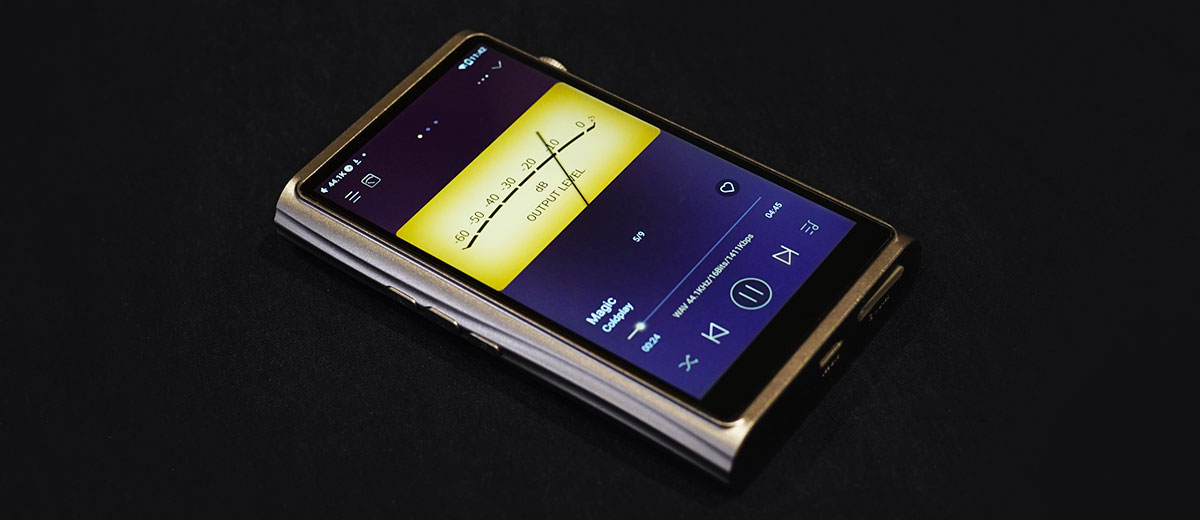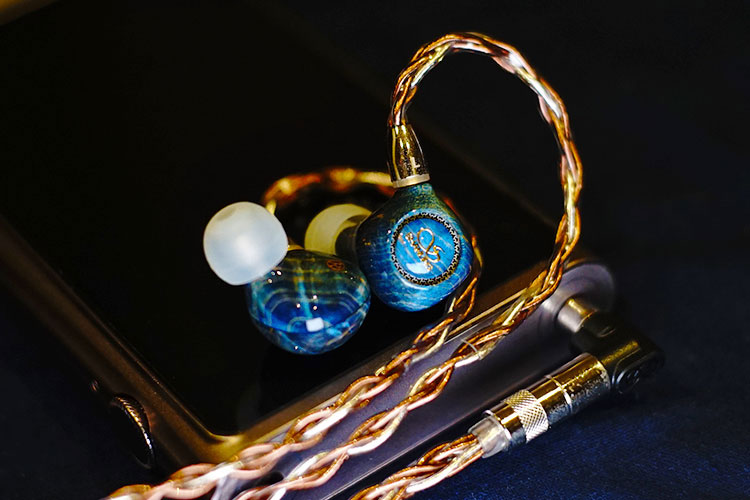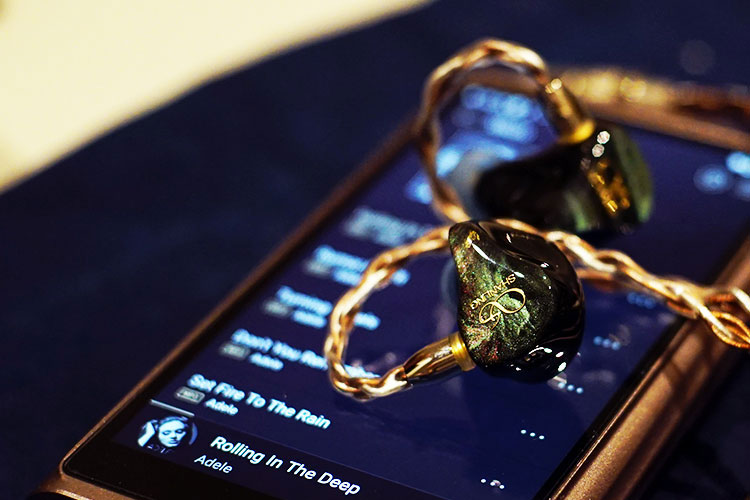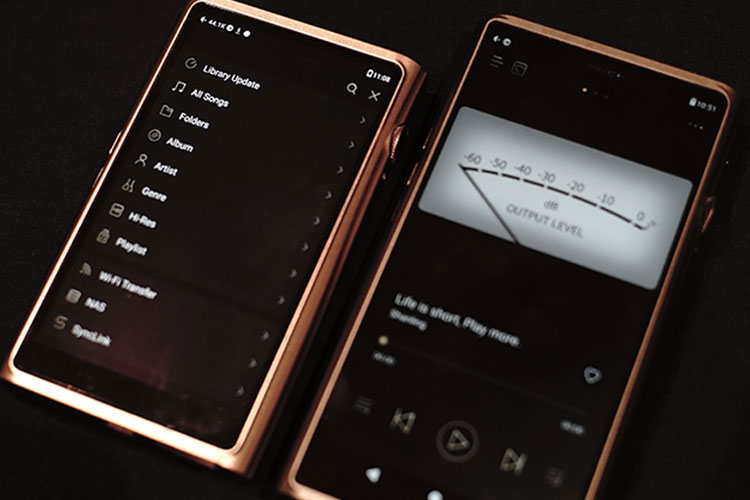Synergy
Efficiency
At low gain, the M7 is completely quiet with sensitive IEMs and CIEMs, but when switching to mid-gain you may start to feel some faint hiss with sensitive IEMs like the Shure SE846. That is quite ignorable to my ears when listening on the go, with Prime Mode picking up slightly less noise.
Switching to higher gain you can feel the full effect of M7’s amplifying circuitries, which is able to deliver strong swings while sounding very quiet in the background with less sensitive IEMs like the Dethonray Tender 1.
Considering the actual dynamics heard the noise control is decent, and with enough volume steps so there are no issues to use the M7 with IEMs.
Power
The M7 is quite powerful on paper being able to output 900mW into a 32Ω load. This is significantly higher than some DAPs within and beyond its price bracket for example the FiiO M15 that offers 800mW @32Ωload.
While being a powerful beast, the M7 is skillfully tuned to sound very dynamic and its finesse in amping design allows pairing with sensitive IEMs and small cans.
Stress testing it with HD600 sounds well-defined and dynamic, but I would prefer a little more power and absolute depth in the bass response.
Pairings
Shanling MG600
The MG600 launched alongside the M7 is not a typical hybrid nor a multi-BA IEM as expected, but a spectacular opened-back design that poses more challenges to current output and control power for fine micro details.
On the M7 the MG600 is pushed to its limits and demonstrates that it is able to sound delicate and refined while delivering a lot of raw power.
Out of my laptop, the MG600 sounds 2D in staging and flat in the mids. That is not the case when pairing with the M7 which immediately jacks up the response speed, dynamics, and separation.
The treble is also more unpolished and sounds hotter when sufficient power is given. The strong power on M7 opens up the box and sounds a lot more expanded, and this pairing outlines the vocal very clearly with a playful impact.
Playing rock music, the paring sounds very uplifting. Listening to Coldplay and Cigarette After Sex tracks, also some blues from the 70s, the sharpness in the upper mids offers more liveliness to studio recordings but may sound a bit sharp with live shows.
Shanling ME800
The ME800 hybrid with switches for user tuning has great synergy with the M7 to sound highly resolving and strong in dynamics. When giving the bass a few more dB using the inbuilt toggle on the ME800 the bass quantity is overwhelming, more sub-bass can be heard and it is able to fill up the hall-sized space rendered very well.
The M7 offers the hybrid IEM some excellent dynamics, deep bass, and defined mid-treble frequencies that together, sound highly engaging and rhythmic.
In listening to Lovers in Japan by Coldplay, the chiming harmonics on guitars and the supporting choruses are well presented, sustaining with good openness. This pairing demonstrates M7’s ability to sound controlled and delicate with its slightly sweetened tuning while still being very powerful when needed.
Select Comparisons
Shanling M9
$2799
Technical
The TOTL flagship M9 with a dual AKM 4499EQ DAC embedded is obviously where M7 is derived from. Both the M7 and M9 are powered by Qualcomm Snapdragon 665 and use Android 10, with 2GB more ram and double the ROM, (256GB), but with a similar UI experience.
The M9 uses AD4610 & BUF364A & OPA1612 in its OP + BUF amping architecture and is able to output up to 920mW into a 32Ω balanced load. The max output is roughly 10% higher than on the M7.
The M9 uses an 8350mAh battery and outputs higher power, it supports 18 hours of playback on SE output and 10 hours in balanced. That is a lot higher than on the M7, which implies that the ESS solution or its amping circuitry is more power-consuming.
Design
The M7 feels like a smaller-sized M9, applying the same design languages and becoming much more portable at just 3/4 the weight of the M9. The M7 feels more exquisite in design due to the smaller size and this time it can go inside the pocket easily.
There is no secondary screen on the M7 and the pixel density is similar to the 6″ 2160*1080 LCD panel on the M9. M7 is also limited to 4.4mm Balanced and 3.5mm single-ended jacks that are fixed on the top panel, unlike M9’s swappable design.
I feel the M7 jack system is more convenient for users who would constantly switch between single-ended and balanced earphones and have access to 4.4mm to 2.5mm convertors.
Performance
When looking into the components some similarities are spotted – M9 uses TI OPA1612, AD ADA4610-2, and TI BUF634 while M7 uses OPA2211, AD ADA4896-2 + MUSES8920 + TI BUF634. Such similarity in architecture brings about similar sound qualities, in particular, speed and sense of control.
Testing with the ME800 on M9 there is more openness and with the stronger transients also mid-bass intensity I perceive a stronger resolution, much more elaborated microdetails, and power.
While both DAPs don’t over emphasize any particular frequencies the M9 outlines every element in the mix sharper and more precise. Though being more confined, M7 lets the listener enjoy the picture as a whole and allows the vocalist to blend into the backing track nicely while maintaining decent separation and definition.
In terms of imaging, the M9 sounds more precisely defined in the mid-treble range and lower bass. On the M7 resonance tones, harmonics and vibratos are more soothing and not as analytical.
The bass is slightly more tilted to the lower end which makes the M7 sound more natural with pop. In contrast, the M9’s grander more elegant presentation could bring out more details for larger ensembles and audiophile recordings.
In case you are using headphones with your DAPs as well, the M9 will definitely sound more dynamic with its stronger output. However, the M7’s smoothness in tuning and softer transients may trick you into feeling it is more expanded when listening outdoors.
FiiO M11 Plus ESS
$799
Technical
The FiiO M11 Plus ESS runs Android 10 OS on Snapdragon 660, with dual ESS ES9068AS and THX AAA-78 amping solutions that can output ≥210mW for single-ended connection and ≥660mW for balanced earphones.
The M11 Plus ESS has 4GB RAM and 64GB ROM onboard which is less than the 6GB RAM and 128GB ROM on the M7 but could be justified with its pricing.
The M11 Plus ESS supports QC4.0 which means you can use a 27W charger to quickly recharge it for a few hours of listening within a short break. Compared to the 18W quick charge standard on Shanling M7 the M11 Plus ESS charges slightly faster.
To be honest, the user experience is quite alike, and FiiO’s customized UI is more convenient for users to tweak while Shanling’s layout is more intuitive and simplified to allow users to focus on music replay.
Design
The M11 Plus ESS has a faceted, sci-fi-themed design that possibly won’t feel out of place on a spaceship. M7 takes a different approach looking curvy and elegant while breathing more warmth into its design. The curvatures feel natural and the matte glass behind textured it classier.
If you are using leather cases, the M11 Plus ESS’s case covers its whole body and the M7’s leather case leaves out the top glass panel and the sexy waist, which makes it more visually alluring.
The 5-inch Full HD panel on the Shanling M7 packs in more pixels than the 5.5-inch 1440*720 panel on the FiiO. Even though the M7 is smaller the visuals are superior to the M11 Plus ESS which has a bigger screen.
Performance
On SE output M7 is 200% more powerful than the M11 Plus ESS making the technical difference more obvious.
Testing with the Etymotic EVO we have recently reviewed, the M7 is more resolving and energetic in the bass, bringing forward punchier dynamics and is able to fill up larger space with rumble.
The M11 Plus ESS sounds softer with its SE output and is not as defined, at the same time it is not as natural sounding compared to the M7.
Moving to the 4.4mm output and testing with the MG600 as well as the Dethonray Tender 1 planar IEMs that is hungry for current, the M11 Plus ESS sounds much more powerful and controlled than on its SE output, though the M7 is still a step stronger in output power while being more resolving and dynamic.
The transients and bass impact are significantly stronger on the M7. The M11 Plus ESS in this case sounds more relaxed and not as polished in the mids.
With various pairings, the M11 Plus ESS is smoother in the lower end and articulates swiftly in the midrange frequencies. It sounds more uncolored though comparatively, it does not hold the image as accurately as on the M7. The M7 is able to bring out more depth, 3D staging, and air which makes it much more engaging in its presentation.
Our Verdict
The Shanling M7 delivers an excellent balance between portability, tonality, and power. It could easily pair with any IEMs and is able to power portable cans to sound very dynamic and loud.
If you are using the M6 Version 21 or the M6 PRO 21, you could clearly feel the leap in performance.
This is a device that has curated all the qualities audiophiles need to enjoy and relax with the music at home or outdoor. It would be even nicer if the battery can last a bit longer but even without that minor quibble, this is an excellent recommendation.
Shanling M7 Technical Specifications
- Dimensions – 129 x 78 x 20 mm
- Weight – 312g
- Display – 5-Inch 1920 * 1080
- Operating System – Open Android 10
- CPU – Qualcomm Snapdragon 665
- Memory – Ram 6GB, ROM 128GB + single Micro SD card slot
- Hi-Res support – 32/768 & DSD512 & MQA 16X
- Bluetooth – Bluetooth 5.0, two-way, LDAC, LHDC, aptX HD, aptX, SBC Support
- Wi-Fi – 2.4G/5G, supporting DLNA, Airplay
- DAC – ESS ES9038PRO
- Amplifier – ADA4896-2 + MUSES8920 + OPA2211 + BUF634
- Output Power – Single-ended 400 mW@32Ohm // 900mW@32Ohm Balanced
- Output – 3.5mm single-ended and 4.4mm balanced
- Output impedance – Less than 1 Ohm
- Battery – 7000 mAh, supporting 18W quick charging
- Battery life – Up to 10 hours in single-ended and 8.5 hours in balanced










